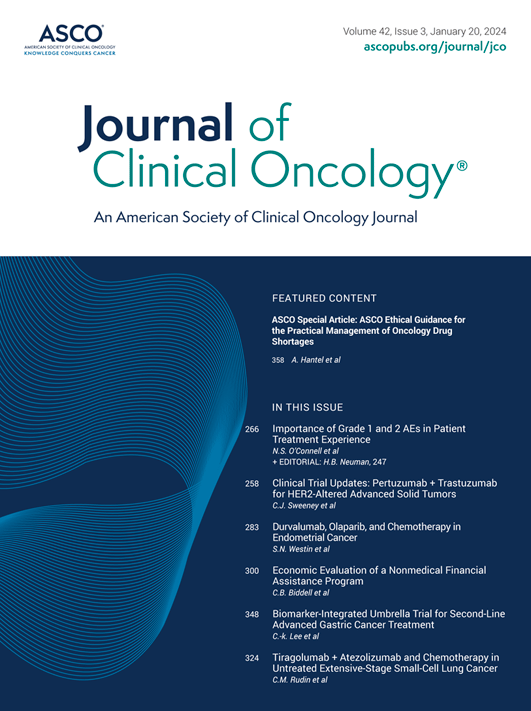Mosunetuzumab plus polatuzumab vedotin in transplant-ineligible refractory/relapsed large B-cell lymphoma: primary results of the phase 3 SUNMO trial.
IF 41.9
1区 医学
Q1 ONCOLOGY
引用次数: 0
Abstract
PURPOSE Prognosis for patients with refractory/relapsed large B-cell lymphoma (LBCL) considered ineligible for curative-intent therapy is poor. The combination of mosunetuzumab, a T-cell-engaging bispecific antibody, and polatuzumab vedotin, an antibody-drug conjugate, (Mosun-Pola), represents a novel fixed-duration outpatient therapy. METHODS In the phase 3 SUNMO trial, patients with refractory/relapsed LBCL who were ineligible for autologous stem cell transplant were randomized (2:1) to receive Mosun-Pola or rituximab, gemcitabine, and oxaliplatin (R-GemOx). Dual primary endpoints were centrally-assessed overall response rate and progression-free survival. Overall survival was a key secondary endpoint. RESULTS A total of 208 patients were randomized to receive Mosun-Pola (n=138) or R-GemOx (n=70). At a median follow-up of 23.2 months, the primary analysis of SUNMO demonstrated that the median progression-free survival was significantly longer with Mosun-Pola than with R-GemOx(11.5 months [95% confidence interval (CI), 5.6-18] vs 3.8 months [95% CI, 2.9-4.1]; hazard ratio for progression or death, 0.41 [95% CI, 0.3-0.6]; P<0.0001). Overall response rate was significantly greater with Mosun-Pola versus R-GemOx (70% vs 40%; P<0.0001), with a complete response rate of 51% and 24%, respectively. In the Mosun-Pola group, the rate of grade ≥2 cytokine release syndrome and usage of tocilizumab occurred in less than 5% of patients, and patient-reported outcomes were improved compared with R-GemOx. CONCLUSION Mosun-Pola demonstrated superior efficacy verus R-GemOx, with significant improvements in both overall response rate and progression-free survival, and infrequent cytokine release syndrome events with a manageable safety profile.(Funded by F. Hoffmann-La Roche Ltd; ClinicalTrials.gov, NCT05171647).Mosunetuzumab联合polatuzumab vedotin治疗不适合移植的难治/复发大b细胞淋巴瘤:3期SUNMO试验的主要结果
目的:难治性/复发性大b细胞淋巴瘤(LBCL)患者的预后不佳,认为不适合进行治愈性治疗。mosunetuzumab是一种与t细胞结合的双特异性抗体,而polatuzumab是一种抗体-药物偶联物(Mosun-Pola),它的联合治疗代表了一种新的固定时间的门诊治疗。方法在3期SUNMO试验中,不适合自体干细胞移植的难治性/复发性LBCL患者随机(2:1)接受Mosun-Pola或利妥昔单抗、吉西他滨和奥沙利铂(R-GemOx)治疗。双主要终点集中评估总缓解率和无进展生存期。总生存期是一个关键的次要终点。结果208例患者随机分为Mosun-Pola组(n=138)和R-GemOx组(n=70)。在中位随访23.2个月时,SUNMO的初步分析表明,Mosun-Pola的中位无进展生存期明显高于R-GemOx(11.5个月[95%置信区间(CI), 5.6-18] vs 3.8个月[95% CI, 2.9-4.1];进展或死亡的风险比为0.41 [95% CI, 0.3-0.6];P < 0.0001)。Mosun-Pola的总有效率明显高于R-GemOx (70% vs 40%, P<0.0001),完全有效率分别为51%和24%。在Mosun-Pola组中,小于5%的患者发生≥2级细胞因子释放综合征和tocilizumab的使用,与R-GemOx相比,患者报告的结果有所改善。结论mosun - pola疗效优于R-GemOx,总体缓解率和无进展生存期均有显著改善,细胞因子释放综合征事件较少,安全性可控。(资助:F. Hoffmann-La Roche Ltd; ClinicalTrials.gov, NCT05171647)。
本文章由计算机程序翻译,如有差异,请以英文原文为准。
求助全文
约1分钟内获得全文
求助全文
来源期刊

Journal of Clinical Oncology
医学-肿瘤学
CiteScore
41.20
自引率
2.20%
发文量
8215
审稿时长
2 months
期刊介绍:
The Journal of Clinical Oncology serves its readers as the single most credible, authoritative resource for disseminating significant clinical oncology research. In print and in electronic format, JCO strives to publish the highest quality articles dedicated to clinical research. Original Reports remain the focus of JCO, but this scientific communication is enhanced by appropriately selected Editorials, Commentaries, Reviews, and other work that relate to the care of patients with cancer.
 求助内容:
求助内容: 应助结果提醒方式:
应助结果提醒方式:


